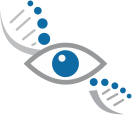You may hear us use terms such as “autosomal dominant” (AD), “autosomal recessive” (AR) and “x-linked recessive” (XL) to describe the way a disease is inherited. To understand these terms and how a disease is passed through families, it is important to know a little bit about genetics.
Genes, which are made up of DNA, are the instructions that our bodies use to make the necessary molecules for our survival and functioning. There are thousands of different genes, each with a specific function. Furthermore, everyone has 2 copies of each gene, one which is inherited from each parent. The 2 copies of each gene are stored on 2 sets of chromosomes. Males have one “X” chromosome and one “Y” chromosome, while females have two “X” chromosomes. We receive one receive chromosome from each of our parents.
When a gene is mutated, it malfunctions and can cause disease. In “autosomal recessive” conditions, both copies of a gene need to be mutated in order for the disease to appear. This means that for a person to develop the disease, he/she must receive a mutated copy of the gene from each parent. If someone only has 1 mutated gene for an “autosomal recessive” disease, then he/she is a carrier and does not develop the disease. If both parents are carriers, then each of their children will have a 25% change to develop the disease. [V1]
In “autosomal dominant” conditions, only 1 mutated copy of a gene is needed for someone to develop the disease. For a parent with an “autosomal dominant” disease, his/her children have a 50% change of developing the disease.
For “x-linked recessive” diseases, the causal gene is only found on the “X” chromosome. Since males only have 1 “X” chromosome (and therefore only 1 copy of the gene), a male with 1 mutated gene for an “x-linked recessive” disease will develop the condition. Families with “x-linked recessive” diseases usually have mostly men who are affected.
Mutations can sometimes develop on their own as well, without being passed on through parents. These are called “sporadic mutations”.
For more information please visit: https://ghr.nlm.nih.gov/primer/basics/gene
